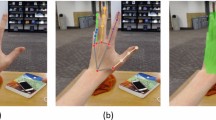Abstract
In this paper, an augmented reality methodology based on the use of a low-invasiveness hand tracking device is presented. The developed methodology, allows the user to be visually immersed into an augmented scene by means of a head-mounted display. He can interact with the virtual objects without any wearable sensor using the Leap Motion Controller that is able to acquire the pose of each finger of both hands by optical triangulation without markers. In this way, the interaction between the user and the scene can be considered “natural”. The interaction between hands and objects and the assembling among objects is achieved by the modification of the Object Active Feature–Grasping Active Feature methodology, based on the use of algebraic kinematic constraint equations. The approach has been adapted to take into account the specific information coming from the tracking device. An example of implementation is reported and an experimental usability study discussed.







Similar content being viewed by others
References
Valentini, P.P., Pezzuti, E., Gattamelata, D.: Virtual Engineering in Augmented Reality, Computer Animation, Series “Computer Science, Technology and Applications”. Nova Publishing, New York (2010)
Merienne, F.: Human factors consideration in the interaction process with virtual environment. Int. J. Interact. Des. Manuf. 4(2), 83–86 (2000)
Valentini, P.P.: Enhancing User Role in Augmented Reality Interactive Simulations, in Human Factors in Augmented Reality Environments, pp. 233–256. Springer, New York (2013)
Wiedenmaier, S., Oehme, O., Schmidt, L., Luczak, H.: Augmented reality (AR) for assembly processes design and experimental evaluation. Int. J. Hum. Comput. Interact. 16, 497–514 (2003)
Pang, Y., Nee, A.Y.C., Ong, S.K., Yuan, M.L., Youcef-Toumi, K.: Assembly feature design in an augmented reality environment. Assem. Autom. 26(1), 34–43 (2006)
Ong, S.K., Pang, Y., Nee, A.Y.C.: Augmented reality aided assembly design and planning. Ann. CIRP 56–1, 49–52 (2007)
Saaski, J., Salonen, T., Hakkarainen, M., Siltanen, S., Woodward, C., Lempiainen, J.: Integration of design and assembly using augmented reality. In: Ratchev, S., Koelemeijer, S. (eds.) IFIP International Federation for Information Processing. Micro-Assembly, Technologies and Applications, vol. 260, pp. 395–404. Springer, Boston (2008)
Valentini, P.P.: Interactive virtual assembling in augmented reality. Int. J. Interact. Des. Manuf. 3, 109–119 (2009)
Chamaret, D., Ullah, S., Richard, P., Naud, M.: Integration and evaluation of haptic feedbacks: from CAD models to virtual prototyping. Int. J. Interact. Des. Manuf. 4, 87–94 (2010)
Toma, M.I., Girbacia, F., Antonya, C.: A comparative evaluation of human interaction for design and assembly of 3D CAD models in desktop and immersive environments. Int. J. Interact. Des. Manuf. 6, 179–193 (2012)
Fiorentino, M., Radkowski, R., Stritzke, C., Uva, A.E., Monno, G.: Design review of CAD assemblies using bimanual natural interface. Int. J. Interact. Des. Manuf. 7, 249–260 (2013)
Valentini, P.P., Pezzuti, E.: Accuracy in fingertip tracking using Leap Motion Controller for interactive virtual applications. Int. J. Interact. Des. Manuf. 11, 641–650 (2017)
Katahira, R., Soga, M.: Development and evaluation of a system for AR enabling realistic display of gripping motions using Leap Motion Controller. Procedia Comput. Sci. 60, 1595–1603 (2015)
Beattie, N., Horan, B., McKenzie, S.: Taking the LEAP with the Oculus HMD and CAD—plucking at thin air? Procedia Technol. 20, 149–154 (2015)
Hui, Z.: Head-mounted display-based intuitive virtual reality training system for the mining industry. Int. J. Min. Sci. Technol. 27, 717–722 (2017)
Chang, K.-H.: E-Design—Computer-Aided Engineering Design. Elsevier, New York (2015)
Haug, E.J.: Computer-Aided Kinematics and Dynamics of Mechanical Systems. Allyn and Bacon, Boston (1988)
Author information
Authors and Affiliations
Corresponding author
Rights and permissions
About this article
Cite this article
Valentini, P.P. Natural interface for interactive virtual assembly in augmented reality using Leap Motion Controller. Int J Interact Des Manuf 12, 1157–1165 (2018). https://doi.org/10.1007/s12008-018-0461-0
Received:
Accepted:
Published:
Issue Date:
DOI: https://doi.org/10.1007/s12008-018-0461-0




